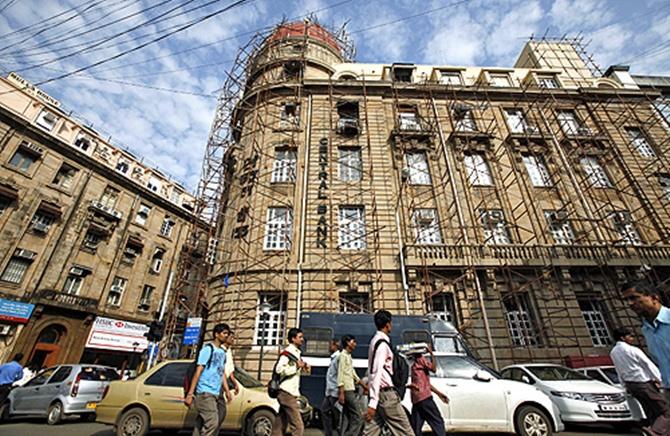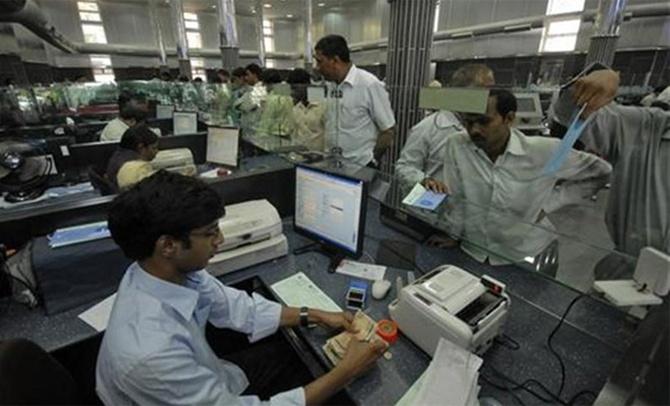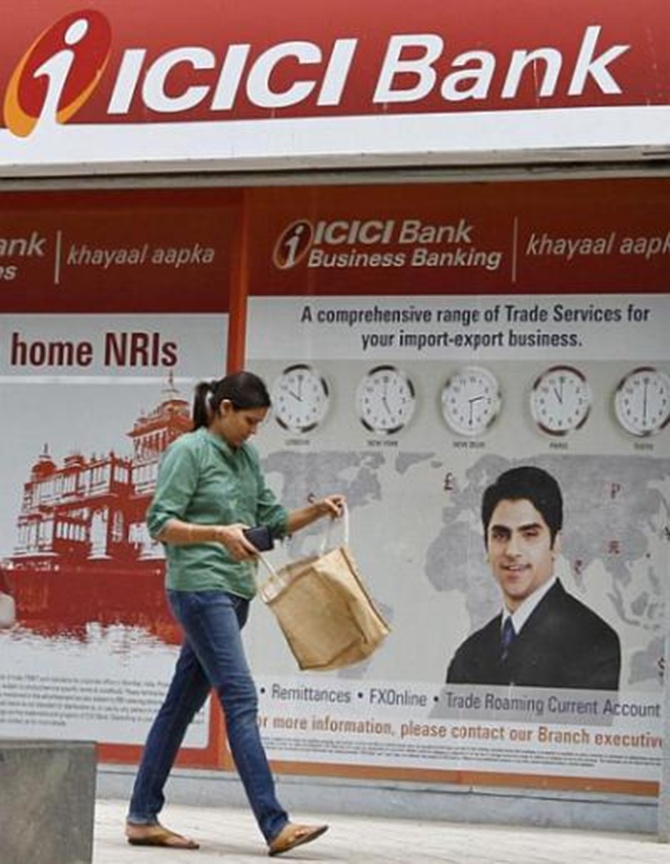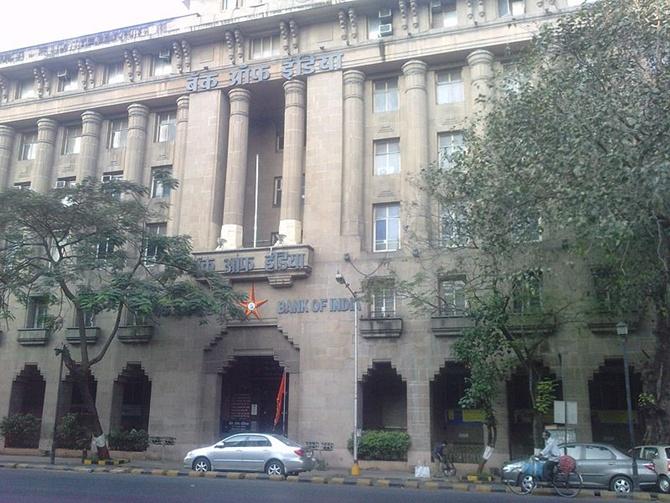 | « Back to article | Print this article |
How to make India's public sector banks perform again
Since public sector banks are unlikely to be privatised soon, the aim has to be to make as many of them perform as is possible, says Subir Roy.
Now that the banking regulator has openly expressed concern over the state of public sector banks and has promised new guidelines on asset classification and resolution, their balance sheets can be expected to reflect a truer picture of their condition.
But that is just coming to terms with reality. Attention must thereafter shift to what needs doing to make them robust again.
Cut-and-dried free market solutions will not help as it will be necessary to understand the historical role of these banks and on that basis devise remedial policies.
The rise in the savings rate of the economy from the low levels at which they were till the '60s has been attributed to two policy actions: one, bank nationalisation and branch expansion; and two, launching of the Unit Trust of India.
It is also recognised that the revolution in customer service at banks has been led by the new private sector banks and their adoption of information technology which forced public sector banks to follow suit. In the process, the latter did themselves a good turn.
Click NEXT to read more...
How to make India's public sector banks perform again
They have been able to retain their market share despite being clearly inferior in their marketing initiatives. It follows that the future for public-sector banks lies along both these paths.
First, public policy must help them to bring banking to the large numbers who are still beyond their pale. When cyclone Aila struck coastal West Bengal a few years ago, rescue workers who first came to the help of stranded communities in the Sundarbans were amazed to find that among the dead, many men had around their waist tight bands inside which were soggy currency notes.
"Clearly banks had not yet reached them and when they faced natural disaster, they held their cash close to themselves," recalls Nitai Mukherjee, director, Hive India, an NGO.
It is also widely recognised that those who do not have anything approaching a reasonable amount of savings keep away from the new private-sector banks which want to ensure all customers bring in a minimum amount of business.
So despite offering poorer customer service, public-sector banks, by simply expanding their reach, have been able to grow. State Bank of India, which has the widest branch and ATM networks, continues to hold on to its share of cheap deposits (current and savings account balances) which is close to being money for jam.
Click NEXT to read more...
How to make India's public sector banks perform again
Running behind
On the other hand, public-sector banks are far behind the new private ones in the profitability stakes. Not only is this not good for the future of any business, lower retained earnings means the shareholders, in this case mainly the government, have to keep recapitalising them at intervals so that they can maintain their capital adequacy ratios while accepting new business.
The first strategic decision that the public-sector banks' owner, the government, has to take is to find out a way to expand in the future while remaining profitable - by extending their own branch network, as in the past, or following an innovative route? Till now, bank branches in rural areas have been metropolitan outposts, with the staff mostly considering rural posting as a kind of punishment.
On the other hand, a microfinance leader like Bandhan is able to cut cost by recruiting a part of their field staff from among the rural communities they serve. The good news is that the government does not want new banks that will come into being with the issue of fresh banking licences to be clones of existing ones.
Click NEXT to read more...
How to make India's public sector banks perform again
If, as has been indicated, innovative forms of banking emerge to cater to the needs of groups like the urban poor or tribals then that will address the unfinished inclusion issue without burdening existing banks.
That apart, what policy decisions can be taken to turn around the bottom line of public sector banks? The bad news is the setback suffered by State Bank of India in seeking to deal with its officers' unions.
An order by the Madras High Court has forced its new chairman to go on reverse gear and continue with the practice of set-off whereby the bank deducts an officer's union contribution from his salary, thus ensuring a steady flow of cash for the unions. But the previous chairman's run in with the officers' unions went deeper and was firmly in the territory of the management's right to manage.
The management has been unsuccessfully trying to introduce a seven-day working week (some private banks already do so). At the same time, taking indirect disciplinary action like transferring an officer has been problematic.
Click NEXT to read more...
How to make India's public sector banks perform again
The way forward
The experience of managers who have spent time with both public sector and private banks is instructive. Soumen Basu, former executive chairman for India of the global human resources consultancy Manpower Inc who has served on both sides of the fence, debunks the myth that "salary" is an issue with public-sector bank managers.
What is an issue is expectations - what is expected of managers and what they expect from the organisation in return. In the private sector, there is "recognition and reward". In the public sector, there is little reward for good work and poor backup for the odd initiative gone awry. What is needed is a professional human resources setup that identifies performers and future leaders through the risk-reward process.
Another manager who served both a public-sector and a private bank recalls how easy it was to access the top management of the private bank who were willing to listen to the advice of operational managers.
And when her turn came to identify managers and setting tasks for them as part of the bank's rapidly expanding operations, she was allowed remarkable freedom.
Click NEXT to read more...
How to make India's public sector banks perform again
A key difference was her ability to offer incentives to managers below her. Another was the personalised customer service she was able to deliver. This mattered in the case of retirees who lived on the interest income from their life's savings kept with the bank and for whom being able to know a face and trust him or her was important.
A former top bank executive considers public-sector bank's key deficiency to be a hierarchical culture. No one voices his opinion on important restructuring decisions which a chief executive takes (say, abolishing the post of deputy general manager), and when this decision turns out to be wrong, a reversal has to wait till a new chief executive comes in.
He attributes the recent rise in NPAs (non-performing assets) to poorer supervision of loans a few years earlier when deputy general managers were gone for a time. Another reason for rising NPAs is not being quick-footed enough. When a private bank sees a loan turning doubtful, it is able to quickly exit, if needed by taking a haircut.
Another element of the government's strategy towards these banks must be to recognise that they are not a monolith. There are some good banks with long traditions and some weak banks which have been so for too long.
There are banks which have a face, past record of innovation and have benefited from periodic dynamic leadership like Bank of India, Bank of Baroda, Canara Bank and Syndicate Bank, to name a few.
They should be encouraged to develop their own cadres with specific ethos and the chief executive should come up from these cadres and not be someone transferred from another bank.
The problems with public- sector banks are similar to those of other public-sector organisations. There are non-performers and then there are out-performers like NTPC and SAIL.
Since public sector banks are unlikely to be privatised soon, the aim has to be to make as many of them perform as is possible.






